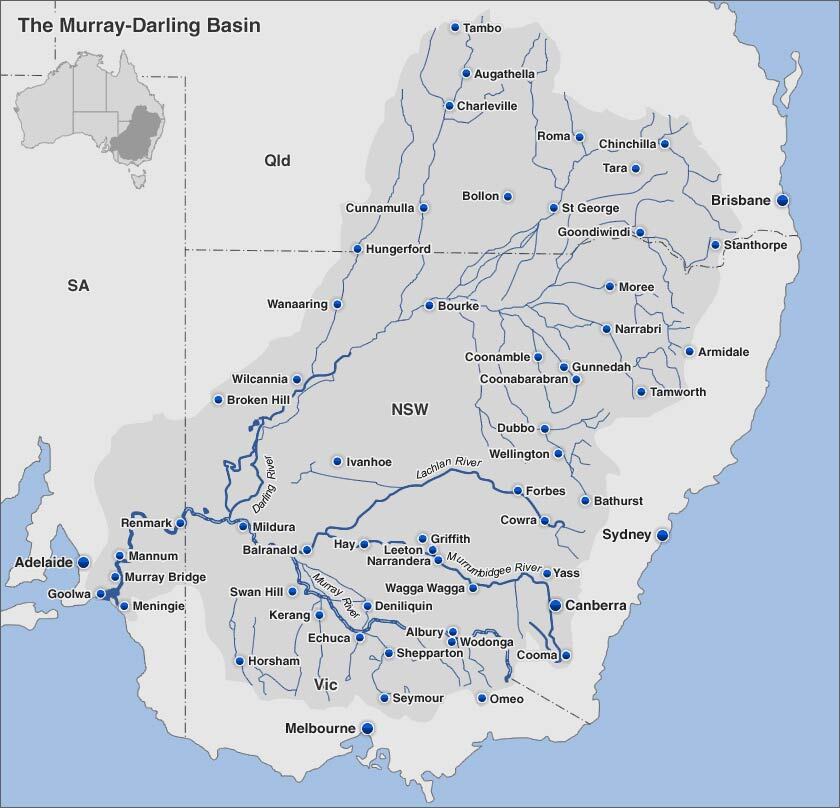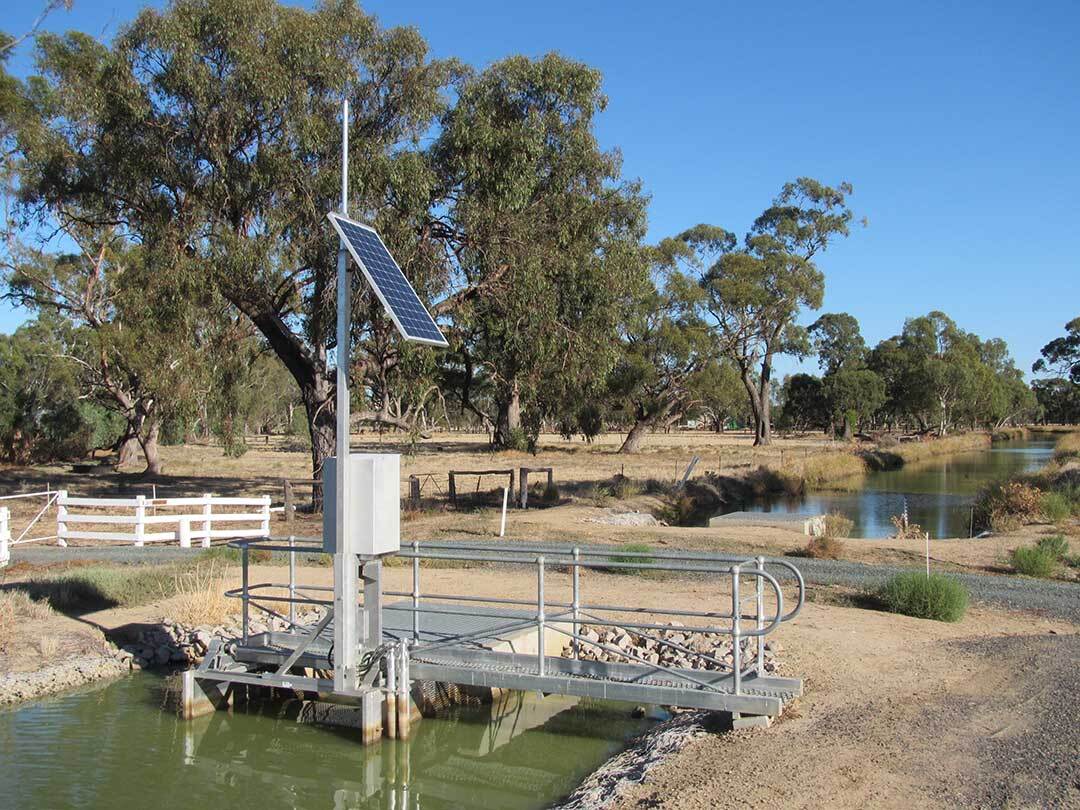How Senix Water Sensors Assist in Australian Irrigation
How do you manage a one-million-square-kilometer area's water conservation efforts? The solution begins with Senix ultrasonic level and distance sensors.
Australia's Irrigation Situation
Irrigation management is serious business in Australia, especially within the Murray-Darling Basin, a 1,000,000 square kilometer watershed that's home to Australia’s most productive agricultural land. The basin’s 23 rivers have some of the lowest and most variable flows in the world. A massive system of dams, lakes, and canals store water from mountain snowmelt and seasonal rains, then distribute it to farms and communities throughout the growing season. 
The Murray-Darling watershed, pictured to the right, has been under pressure since the 1960s, but a series of environmental and economic crises in the 1990s created momentum for changing the way water resources were managed. In 1991, a 1,000-kilometer outbreak of blue-green algae on the Murray River became a vivid symbol of the environmental stress associated with reduced river flows.
Reduced flows began threatening sensitive wetlands, protected species, and salinity levels throughout the watershed. These water shortages threatened everyone: including farms, industry, municipalities, and tourism.
The Response
The Murray-Darling Authority was created in 2007 to develop the first cross-border water resource management plan. In 2012, the Murray-Darling Basin Plan became law.
Once implemented, the plan would return 2,750 gigaliters of surface water to the environment. An additional $1.7 billion AUD was appropriated to provide an additional 450 gigaliters to the environment. The total 3,200 gigaliters would be provided in two basic ways: modernization and automation of irrigation infrastructure, from one end of the watershed to the other; and government-authorized selective water rights purchases on behalf of the environment.
Murray Irrigation, Australia’s largest privately owned irrigation company, manages irrigation along the upper reaches of the Murray River in southeastern New South Wales. Their system distributes water to more than 2,300 farms, covering approximately 750,000 hectares through almost 3,000 kilometers of gravity-fed earthen channels.
Australia's Painstaking Irrigation Management History
Managing this decades-old irrigation system has been a complex undertaking. Farm customers requested seasonal allocation of water based on the weather, crop maturity, soil conditions and other factors. Water orders had to be placed up to seven days in advance to allow for coordination, but a lot can change in a farm field in seven days.
Delivering water through a spiderweb of surface channels is a complex manual process. Water levels and releases in each channel had to be balanced so that each customer received their water allotment, regardless of their location in the distribution system. Murray Irrigation had to balance the requests of 2,300 farms—as well as the needs of industrial and municipal customers—on a day-to-day basis, all while staying within Murray’s allocation stated in the greater Murray-Darling Basin Plan.
Historically, the system was managed manually through a system of channel control gates and mechanical water meters. Irrigation staff would travel to channel control points and raise gates to a certain height for a specified duration in order to release water to downstream channels.
Dozens of people positioned throughout the 3,000 kilometers of channels would attempt to coordinate water levels so that each farm customer received their requested water allocation when they wanted it. Customer water usage was typically measured with mechanical meters that had to be visited periodically to monitor consumption. Large contingency releases of water were necessary to make sure that end-of-the-line customers received the water volume they were entitled to with sufficient flow to make consistent field irrigation possible.
The system was labor intensive and imprecise, but it was cost effective as long as water was plentiful. But as devastating droughts and routine water scarcity grows, employing a more efficient system became critical.
Ultrasonics Provide a Solution
Murray Irrigation began their Private Irrigation Infrastructure Operators Program (PIIOP) in 2013 with a goal to reduce water distribution losses. In need of an autonomous, rugged sensor, they chose the Senix ToughSonic 14 ultrasonic sensors to provide real-time water level measurements to guide channel control structures in the new system. 
Murray Irrigation is implementing two levels of system automation. In Standard Level of Service (SLOS) areas, irrigation control points are controlled remotely. ToughSonic ultrasonic sensors are mounted near each gate provide water level measurement data to Murray’s SCADA system. Control center operators monitor channel levels, water orders, and issue remote gate movement commands to release water based on known time and volume parameters. Accurate and responsive, this system allows farmers to change their water orders every 12 hours.
In High Level of Service (HLOS) areas, irrigation control points are automatically controlled based on established parameters. Irrigation customers submit water orders online, then the irrigation management system issues gate manipulation commands. The system monitors water level data from the ultrasonic level sensors and other sensor inputs to determine the quantity of water delivered. HLOS systems allow irrigation customers to order water as frequently as four times per day if overall system flow allows.
In both service areas, water is distributed with precision and without the need for large and potentially wasteful contingency releases. Farmers benefit from shorter lead times and more stable flows, allowing them to water crops more precisely, reduce overall water consumption, and maintain healthy crop yields.
Senix modified the ToughSonic 14 sensor to reduce energy consumption and improve surge protection during lightning storms.
"Changing weather patterns—combined with population growth—are creating crippling droughts in many parts of the world," said Doug Boehm, Senix Founder & President. "Australia is meeting these challenges with effective policy change and major investments in irrigation automation technology."
The more precious water supplies become, the more carefully they need to be managed. Murray Irrigation is implementing one of the most sophisticated irrigation distribution systems in the world with state-of-the-art sensors, gates, and SCADA technology, all designed to reduce waste and improve customer service.
For more information on how Senix can help with your application, contact us at info@senix.com or click here.

